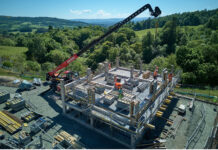
EDINBURGH’S new £150 million Royal Hospital for Children and Young People has utilised more than 300,000 Polypipe Permavoid and Polystorm-R components for water attenuation systems.
Polypipe, working with contractor Multiplex, supplied eleven shallow attenuation tanks, which have been installed under parking bays and entrances, including the hospital’s A&E departments.
Polypipe explained that a sub-base replacement design was needed to store the appropriate level of water above the high water table that gathers on site during heavy rainfall. The Permavoid geocellular system was chosen as the primary engineered solution.
Ten of the tanks used Permavoid 150mm, with one tank using a combination of Polystorm-R with Polystorm Access and Polystorm Inspect. The Permavoid tanks are being used beneath permeable and non-permeable paving, wrapped in geomembrane to make the tanks watertight for attenuation. Permatex, the polypropylene geotextile, has been installed between the Permavoid layers to ensure passive water infiltration into the tanks.
Polypipe said the “innate strength” of its geocellular solutions makes them ideal for heavily trafficked areas, and the 95% void fill ratio of the Permavoid system enhances ground attenuation by storing excess water below ground level.
Jonathon Mays, procurement manager at Multiplex said, “Polypipe was a clear choice for this project as its technical experts were able to assess onsite requirements and define the right products and quantities needed. By working with merchant partner, PDM, the easy to install Permavoid and Polystorm-R systems could be delivered to site on a timely basis and quickly put into position. Using a geocellular system also reduced the amount of land that needed to be excavated from the site.”
Rosie Cheetham, marketing manager at Polypipe Civils added, “There were a number of interesting challenges on this project, including the contractor’s need to keep the site open to hospital traffic, and the high water table on site posing a technical problem to solve. The onsite teams were able to coordinate deliveries to meet strict installation schedules – ensuring disruption on-site was kept to a minimum, and the geocellular tanks, positioned above the high water table, provides a high tensile strength and flexibility that will be able to endure all levels of traffic for years to come.”










